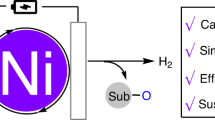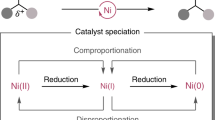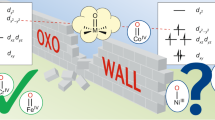Abstract
Metal-dioxygen adducts, such as metal-superoxo and -peroxo species, are key intermediates often detected in the catalytic cycles of dioxygen activation by metalloenzymes and biomimetic compounds. The synthesis and spectroscopic characterization of an end-on nickel(II)-superoxo complex with a 14-membered macrocyclic ligand was reported previously. Here we report the isolation, spectroscopic characterization, and high-resolution crystal structure of a mononuclear side-on nickel(III)-peroxo complex with a 12-membered macrocyclic ligand, [Ni(12-TMC)(O2)]+ (1) (12-TMC = 1,4,7,10-tetramethyl-1,4,7,10-tetraazacyclododecane). In contrast to the end-on nickel(II)-superoxo complex, the nickel(III)-peroxo complex is not reactive in electrophilic reactions, but is capable of conducting nucleophilic reactions. The nickel(III)-peroxo complex transfers the bound dioxygen to manganese(II) complexes, thus affording the corresponding nickel(II) and manganese(III)-peroxo complexes. Our results demonstrate the significance of supporting ligands in tuning the geometric and electronic structures and reactivities of metal–O2 intermediates that have been shown to have biological as well as synthetic usefulness in biomimetic reactions.
This is a preview of subscription content, access via your institution
Access options
Subscribe to this journal
Receive 12 print issues and online access
$259.00 per year
only $21.58 per issue
Buy this article
- Purchase on Springer Link
- Instant access to full article PDF
Prices may be subject to local taxes which are calculated during checkout






Similar content being viewed by others
References
Nam, W. (ed.) Special issue on dioxygen activation by metalloenzymes and models. Acc. Chem. Res. 40, 465–634 (2007).
Unno, M., Chen, H., Kusama, S., Shaik, S. & Ikeda-Saito, M. Structural characterization of the fleeting ferric peroxo species in myoglobin: experiment and theory. J. Am. Chem. Soc. 129, 13394–13395 (2007).
Kovaleva, E. G. & Lipscomb, J. D. Crystal structures of Fe2+ dioxygenase superoxo, alkylperoxo, and bound product intermediates. Science 316, 453–457 (2007).
Prigge, S. T., Eipper, B. A., Mains, R. E. & Amzel, L. M. Dioxgyen binds end-on to mononuclear copper in a precatalytic enzyme complex. Science 304, 864–867 (2004).
Klotz, I. M. & Kurtz, D. M. Jr (eds) Special issue on metal-dioxygen complexes. Chem. Rev. 94, 567–856 (1994).
Wertz, D. L. & Valentine, J. S. Nucleophilicity of iron-peroxo porphyrin complexes. Struct. Bonding 97, 37–60 (2000).
Girerd, J.-J., Banse, F. & Simaan, A. J. Characterization and properties of non-heme iron peroxo complexes. Struct. Bonding 97, 145–177 (2000).
Bakac, A. Kinetic and mechanistic studies of the reactions of transition metal-activated oxygen with inorganic substrates. Coord. Chem. Rev. 250, 2046–2058 (2006).
Hikichi, S., Akita, M. & Moro-oka, Y. New aspects of the cobalt-dioxygen complex chemistry opened by hydrotris(pyrazoly)borate ligands (TpR): unique properties of TpRCo-dioxygen complexes. Coord. Chem. Rev. 198, 61–87 (2000).
Mirica, L. M., Ottenwaelder, X. & Stack, T. D. P. Structure and spectroscopy of copper−dioxygen complexes. Chem. Rev. 104, 1013–1045 (2004).
Lewis E. A. & Tolman, W. B. Reactivity of dioxygen-copper systems. Chem. Rev. 104, 1047–1076 (2004).
Hatcher, L. Q. & Karlin, K. D. Oxidant types in copper-dioxygen chemistry: the ligand coordination defines the Cun-O2 structure and subsequent reactivity. J. Biol. Inorg. Chem. 9, 669–683 (2004).
Itoh, S. Mononuclear copper active-oxygen complexes. Curr. Opin. Chem. Biol. 10, 115–122 (2006).
Cramer, C. J. & Tolman, W. B. Mononuclear Cu−O2 complexes: geometries, spectroscopic properties, electronic structures, and reactivity. Acc. Chem. Res. 40, 601–608 (2007).
Rolff, M. & Tuczek, F. How do copper enzymes hydroxylate aliphatic substrates? Recent insights from the chemistry of model systems. Angew. Chem. Int. Ed. 47, 2344–2347 (2008).
Chen, P. & Solomon, E. I. O2 activation by binuclear Cu sites: noncoupled versus exchange coupled reaction mechanisms. Proc. Natl Acad. Sci. USA 101, 13105–13110 (2004).
Fujisawa, K., Tanaka, M., Moro-oka, Y. & Kitajima, N. A monomeric side-on superoxocopper(II) complex: Cu(O2)(HB(3-tBu-5-iPrpz)3). J. Am. Chem. Soc. 116, 12079–12080 (1994).
Spencer, D. J. E., Aboelella, N. W., Reynolds, A. M., Holland, P. L. & Tolman, W. B. β-Diketiminate ligand backbone structural effects on Cu(I)/O2 reactivity: unique copper−superoxo and bis(μ-oxo) complexes. J. Am. Chem. Soc. 124, 2108–2109 (2002).
Würtele, C. et al. Crystallographic characterization of a synthetic 1:1 end-on copper dioxygen adduct complex. Angew. Chem. Int. Ed. 45, 3867–3869 (2006).
Gherman, B. F. & Cramer, C. J. Modeling the peroxide/superoxide continuum in 1:1 side-on adducts of O2 with Cu. Inorg. Chem. 43, 7281–7283 (2004).
Aboelella, N. W. et al. Dioxygen activation at a single copper site: structure, bonding, and mechanism of formation of 1:1 Cu-O2 Adducts. J. Am. Chem. Soc. 126, 16896–16911 (2004).
Reynolds, A. M., Gherman, B. F., Cramer, C. J. & Tolman, W. B. Characterization of a 1:1 Cu-O2 adduct supported by an anilido imine ligand. Inorg. Chem. 44, 6989–6997 (2005).
Sarangi, R. et al. X-ray absorption edge spectroscopy and computational studies on LCuO2 species: superoxide − CuII versus peroxide − CuIII bonding. J. Am. Chem. Soc. 128, 8286–8296 (2006).
Kieber-Emmons, M. T. & Riordan, C. G. Dioxygen activation at monovalent nickel. Acc. Chem. Res. 40, 618–625 (2007).
Kieber-Emmons, M. T. et al. Identification of an “end-on” nickel−superoxo adduct, [Ni(TMC)(O2)]+. J. Am. Chem. Soc. 128, 14230–14231 (2006).
Yao, S., Bill, E., Milsmann, C., Wieghardt, K. & Driess, M. A ‘side-on’ superoxonickel complex [LNi(O2)] with a square-planar tetracoordinate nickel(II) center and its conversion into [LNi(μ-OH)2NiL]. Angew. Chem. Int. Ed. 47, 7110–7113 (2008).
Matsumoto, M. & Nakatsu, K. Dioxygen-bis-(t-butylisocyanide)nickel. Acta Cryst. B31, 2711–2713 (1975).
Haines, R. I. & McAuley, A. Synthesis and reactions of nickel(III) complexes. Coord. Chem. Rev. 39, 77–119 (1981).
Cho, J. et al. Sequential reaction intermediates in aliphatic C − H bond fuctionalization initiated by a bis(μ-oxo)dinickel(III) complex. Inorg. Chem. 45, 2873–2885 (2006).
Evans, D. F. & Jakubovic, D. A. Water-soluble hexadentate Schiff-base lignads as sequestrating agents for iron(III) and gallium(III). J. Chem. Soc. Dalton Trans. 2927–2933 (1988).
Cramer, C. J., Tolman, W. B., Theopold, K. H. & Rheingold, A. L. Varible character of O−O and M−O bonding in side-on (η2) 1:1 metal complexes of O2 . Proc. Natl Acad. Sci. USA 100, 3635–3640 (2003).
Shulman, R. G., Yafet, Y., Eisenberger, P. & Blumberg, W. E. Observation and interpretation of X-ray absorption edges in iron compounds and proteins. Proc. Natl Acad. Sci. USA 73, 1384–1388 (1976).
Colpas, G. J. et al. X-ray spectroscopic studies of nickel complexes, with application to the structure of nickel sites in hydrogenases. Inorg. Chem. 30, 920–928 (1991).
Vaz, A. D. N., Roberts, E. S. & Coon, M. J. Olefin formation in the oxidative deformylation of aldehydes by cytochrome P-450. Mechanistic implications for catalysis by oxygen-derived peroxide. J. Am. Chem. Soc. 113, 5886–5887 (1991).
Seo, M. S. et al. [Mn(TMC)(O2)]+: a side-on peroxido manganese(III) complex bearing a non-heme ligand. Angew. Chem. Int. Ed. 46, 377–380 (2007).
Kieber-Emmons, M. T., Schenker, R., Yap, G. P. A., Brunold, T. C. & Riordan, C. G. Spectroscopic elucidation of a peroxo Ni2(μ-O2) intermediate derived from a nickel(I) complex and dioxygen. Angew. Chem. Int. Ed. 43, 6716–6718 (2004).
Aboelella, N. W. et al. Mixed metal bis(μ-oxo) complexes with [CuM(μ-O)2]n+ (M = Ni(III) or Pd(II)) cores. Chem. Commun. 1716–1717 (2004).
Chufán, E. E., Puiu, S. C. & Karlin, K. D. Heme − copper/dioxygen adduct formation, properties, and reactivity. Acc. Chem. Res. 40, 563–572 (2007).
Acknowledgements
The research was supported by KOSEF/MEST of Korea through the CRI and WCU (R31-2008-000-10010-0) Programs (W.N.), SBS Foundation (W.N.), the Ministry of Education, Culture, Sports, Science and Technology of Japan through the Global COE program and Priority Area (No. 20050029) (T.O.), and NIH grant DK-31450 (E.I.S.). SSRL operations are funded by the Department of Energy, Office of Basic Energy Sciences. The SSRL Structural Molecular Biology program is supported by the National Institutes of Health, National Center for Research Resources, Biomedical Technology Program, and the Department of Energy, Office of Biological and Environmental Research.
Author information
Authors and Affiliations
Contributions
J.C., E.I.S., and W.N. conceived and designed the experiments; J.C., R.S., J.A., S.Y.K., and M.K. performed the experiments; J.C., R.S., J.A., M.K., and T.O. analysed the data; J.C., R.S., E.I.S., and W.N. co-wrote the paper.
Corresponding authors
Supplementary information
Supplementary information
Supplementary information (PDF 777 kb)
Supplementary information
Crystallographic information for compound 1 (CIF 18 kb)
Supplementary information
Crystallographic information for compound 3 (CIF 13 kb)
Rights and permissions
About this article
Cite this article
Cho, J., Sarangi, R., Annaraj, J. et al. Geometric and electronic structure and reactivity of a mononuclear ‘side-on’ nickel(iii)–peroxo complex. Nature Chem 1, 568–572 (2009). https://doi.org/10.1038/nchem.366
Received:
Accepted:
Published:
Issue Date:
DOI: https://doi.org/10.1038/nchem.366
This article is cited by
-
Electronic structures and energetic of metal(II)-superoxo species: a DFT exploration
Structural Chemistry (2023)
-
A comprehensive correlated analysis of Ra-Doped (ZnO2, ZnO) for optoelectronic applications: a first-principle study
Journal of Molecular Modeling (2023)
-
Electrochemically induced nickel catalysis for oxygenation reactions with water
Nature Catalysis (2021)
-
Study of behaviour of Ni(III) macrocyclic complexes in acidic aqueous medium through kinetic measurement involving hydrogen peroxide oxidation and DFT calculations
Journal of Chemical Sciences (2017)
-
Oxygen activation by mononuclear Mn, Co, and Ni centers in biology and synthetic complexes
JBIC Journal of Biological Inorganic Chemistry (2017)



